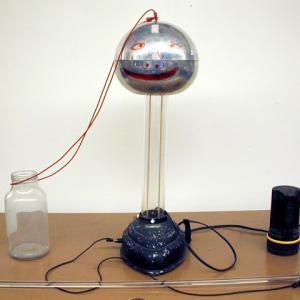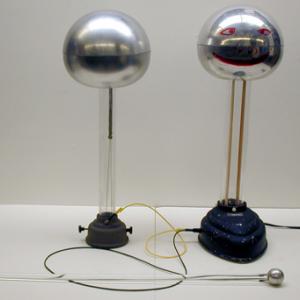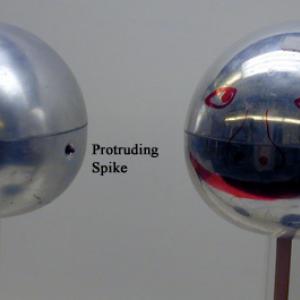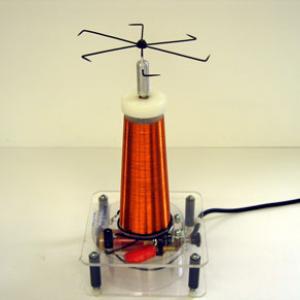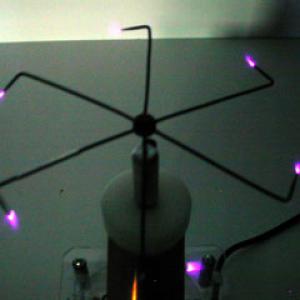College of Liberal Arts & Sciences
5B30.35 - Corona Discharge
Set the apparatus as shown. Retract the metal spike and start the generator. Notice that there is charge buildup but no arcing between the spheres. Stick the spike out of the ball and point towards the generator and note the arcing. Turn the spike away from the generator and observe the corona. This is best observed in a darkened room. Refer to Eb - 2 for charge sign information. In our case the Van de Graaff generator should have a negative charge.
A much easier way to demonstrate corona is to put the pinwheel onto the point of either of the two larger Tesla coils. Very nice corona will be visible at each point of the pinwheel.
- Richard E. Orville, "The Lightning Discharge", TPT, Vol. 14, # 1, January 1976, p. 7.
- Eb-2: Freier and Anderson, A Demonstration Handbook for Physics.
- J. B. A. Mitchell et al., "Nanoparticles in Ball Lightning", Physics Today, Vol. 61, # 2, Feb. 2008, p. 18.
- E. Philip Krider, "Benjamin Franklin and Lightning Rods", Physics Today, Jan. 2006, p. 42.
- Jearl Walker, "5.21, St. Elmo's fire and Andes Glow", The Flying Circus of Physics Ed. 2, p. 228.
- Jearl Walker, "5.7, Lightning Rods", The Flying Circus of Physics Ed. 2, p. 221.
- Jearl Walker, "3.56, Thunder", The Flying Circus of Physics Ed. 2, p. 168.
Disclaimer: These demonstrations are provided only for illustrative use by persons affiliated with The University of Iowa and only under the direction of a trained instructor or physicist. The University of Iowa is not responsible for demonstrations performed by those using their own equipment or who choose to use this reference material for their own purpose. The demonstrations included here are within the public domain and can be found in materials contained in libraries, bookstores, and through electronic sources. Performing all or any portion of any of these demonstrations, with or without revisions not depicted here entails inherent risks. These risks include, without limitation, bodily injury (and possibly death), including risks to health that may be temporary or permanent and that may exacerbate a pre-existing medical condition; and property loss or damage. Anyone performing any part of these demonstrations, even with revisions, knowingly and voluntarily assumes all risks associated with them.
